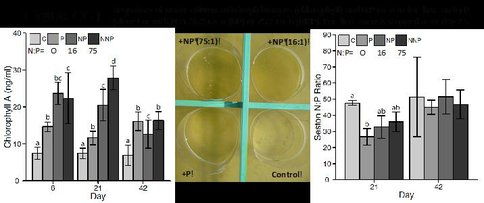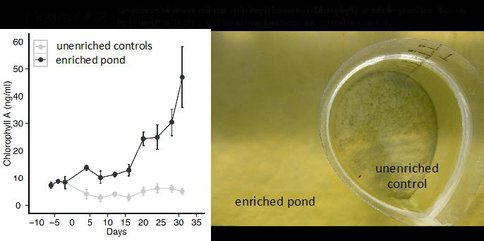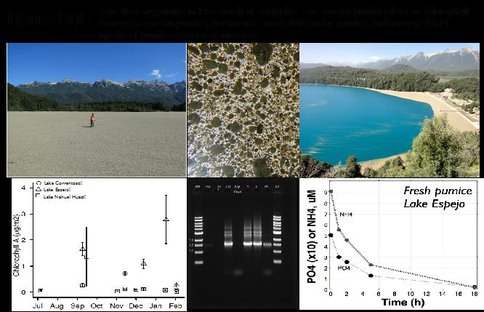2012 Annual Science Report
 Arizona State University
Reporting | SEP 2011 – AUG 2012
Arizona State University
Reporting | SEP 2011 – AUG 2012
Stoichiometry of Life, Task 2b: Field Studies - Cuatro Cienegas
Project Summary
Cuatro Cienegas is a unique biological preserve in México (state of Coahuila) in which there is striking microbial diversity, potentially related to extreme scarcity of phosphorus. We aim to understand this relationship via field sampling of biological and chemical characteristics and a series of enclosure and whole-pond fertilization experiments. These studies help in identifying the element signatures that microbes develop when key nutrient elements are scarce. Furthermore, the chemical and physical environments of the desert aquatic habitats at Cuatro Cienegas are analogous to those that may have existed on Mars during times in its past when it was losing its own surface water. Thus, these data may help in interpreting information about element signatures obtained from the Curiosity rover as it explores Gale Crater.
Project Progress
Cuatro Ciénegas is a unique biological preserve in México (state of Coahuila) in which there is striking microbial diversity, potentially related to extreme scarcity of phosphorus. We aim to understand this relationship via field sampling of biological and chemical characteristics and a series of enclosure and whole-pond fertilization experiments aimed at testing the effects of NP fertilization on the multi-element composition of microbes.
Overview of CC: During 2012 members of our team completed and published several manuscripts reviewing the microbiological and astrobiological attributes of the Cuatro Ciénegas basin; Volume 12, Number 7 of Astrobiology was devoted to eight of these articles. Our work also caught the attention of the New York Times which produced a News article (“Learning About Life on Mars, via a Detour to Mexico”) related to Valeria Souza’s continued work on conservation of the basin and its relevance to astrobiology “http://www.nytimes.com/2012/06/27/world/americas/learning-about-life-on-mars-by-studying-mexico-desert.html?_r=1&”:http://www.nytimes.com/2012/06/27/world/americas/learning-about-life-on-mars-by-studying-mexico-desert.html?_r=1&; June 26 2012.
Phosphorus limitation and element use in microbial communities: During the past year we completed the chemical analyses of samples from the summer 2011 experiment performed in Lagunita, Churince Basin, at Cuatro Cienegas that manipulated P supply and N:P ratio in replicate mesocosms. The responses of water column microbial phototroph biomass to P fertilization were rapid and strong and indicative of NxP synergistic interaction (see Figure CC1). Most data analyses for water column samples are complete while analyses of sediment responses in C:N:P ratios are underway. We have also extracted samples for construction of microbial community structure (16S ribotag sequencing) and transcriptomic response. These samples are now at JCVI for analysis by Chris Dupont. A manuscript describing the biogeochemical results is now being drafted and an abstract reporting the results was submitted for the February 2013 ASLO meeting.
During summer 2012 we completed the planned “whole pond” P fertilization experiment at Lagunita. Five control mesocosms were installed and then the pond was fertilized periodically (3-5 d intervals) with inorganic P and N to maintain PO4 at a target of 1 uM. The response of water column phototroph biomass was substantial and immediate (Figure CC2). Prior to fertilization, a set of samples was taken for processing for metagenomic analysis; at the end of the 7-week fertilization period, another set was taken for metagenomic and transcriptomic analysis. Biogeochemical and genomic samples are now being processed.
Calcification, nutrient cycling, and microbial community structure in Río Mezquites stromatolites
PhD candidate Jessica Corman continued her work to understand formation of, and nutrient cycling processes associated with, oncoid stromatolites. During summer 2012, she sampled phenotypically distinct oncoid stromatolites for nutrient and microbial community analysis. Dr. Amisha Poret-Peterson and Corman, along with undergraduate Alisa Glukhova are characterizing the response of oncoid microbial communities to changes in nutrient and light availability with T-RFLP analysis.
Environmental, microbial, and stoichiometric diversity at Cuatro Ciénegas
In continuation of regular environmental sampling, PhD students Jessica Corman and Jorge Ramos sampled over 30 distinct water bodies in the valley during summer 2012. Water and sediment samples were collected for major and minor elemental analysis. Jessica Corman also continued the ecological and microbiological monitoring of succession in the Pozas Rojas, an area of saline pools that was affected by a massive flood in July 2010. Initial results of these studies were presented at the 2012 Ecological Society of America (ESA) Annual Meeting.
Environmental microbiology. UNAM researcher Valeria Souza continued to advance studies in association with the NASA NAI project to describe the genetic composition and microbial community structure of various ecosystems at Cuatro Ciénegas, including soil and sediment microbes as well as the microbes composing various stromatolite structures in the basin. Publications from this work include those featured in the special issue of Astrobiology mentioned earlier.
Responses of water column autotroph biomass (chlorophyll) and N:P ratio to fertilization by P (alone) or with N at 16:1 ratio (NP) or 75:1 ratio (NNP). Fertilization was stopped after day 21.
Responses of water column autotroph biomass (chlorophyll) to whole-pond fertilization by N and P at 16:1 ratio. Five internal mesocosms served as controls.
Top: floating pumice in lakes north of Bariloche. Bottom: preliminary data o chlorophyll concentrations on pumice, documentation of DNA on the pumice, and nutrient (n,P) uptake of pumice-asociated microbes.
Publications
-
Bonilla-Rosso, G., Peimbert, M., Alcaraz, L. D., Hernández, I., Eguiarte, L. E., Olmedo-Alvarez, G., & Souza, V. (2012). Comparative Metagenomics of Two Microbial Mats at Cuatro Ciénegas Basin II: Community Structure and Composition in Oligotrophic Environments. Astrobiology, 12(7), 659–673. doi:10.1089/ast.2011.0724
-
López-Lozano, N. E., Eguiarte, L. E., Bonilla-Rosso, G., García-Oliva, F., Martínez-Piedragil, C., Rooks, C., & Souza, V. (2012). Bacterial Communities and the Nitrogen Cycle in the Gypsum Soils of Cuatro Ciénegas Basin, Coahuila: A Mars Analogue. Astrobiology, 12(7), 699–709. doi:10.1089/ast.2012.0840
-
Moreno-Letelier, A., Olmedo-Alvarez, G., Eguiarte, L. E., & Souza, V. (2012). Divergence and Phylogeny of Firmicutes from the Cuatro Ciénegas Basin, Mexico: A Window to an Ancient Ocean. Astrobiology, 12(7), 674–684. doi:10.1089/ast.2011.0685
-
Nitti, A., Daniels, C. A., Siefert, J., Souza, V., Hollander, D., & Breitbart, M. (2012). Spatially Resolved Genomic, Stable Isotopic, and Lipid Analyses of a Modern Freshwater Microbialite from Cuatro Ciénegas, Mexico. Astrobiology, 12(7), 685–698. doi:10.1089/ast.2011.0812
-
Peimbert, M., Alcaraz, L. D., Bonilla-Rosso, G., Olmedo-Alvarez, G., García-Oliva, F., Segovia, L., … Souza, V. (2012). Comparative Metagenomics of Two Microbial Mats at Cuatro Ciénegas Basin I: Ancient Lessons on How to Cope with an Environment Under Severe Nutrient Stress. Astrobiology, 12(7), 648–658. doi:10.1089/ast.2011.0694
-
Siefert, J. L., Souza, V., Eguiarte, L., & Olmedo-Alvarez, G. (2012). Microbial Stowaways: Inimitable Survivors or Hopeless Pioneers?. Astrobiology, 12(7), 710–715. doi:10.1089/ast.2012.0833
-
Souza, V., Eguiarte, L. E., Travisano, M., Elser, J. J., Rooks, C., & Siefert, J. L. (2012). Travel, Sex, and Food: What’s Speciation Got to Do with It?. Astrobiology, 12(7), 634–640. doi:10.1089/ast.2011.0768
-
Souza, V., Siefert, J. L., Escalante, A. E., Elser, J. J., & Eguiarte, L. E. (2012). The Cuatro Ciénegas Basin in Coahuila, Mexico: An Astrobiological Precambrian Park. Astrobiology, 12(7), 641–647. doi:10.1089/ast.2011.0675
-
PROJECT INVESTIGATORS:
-
PROJECT MEMBERS:
Ariel Anbar
Co-Investigator
Christopher Dupont
Collaborator
Luis Eguiarte
Collaborator
Jason Raymond
Collaborator
Janet Siefert
Collaborator
Valeria Souza
Collaborator
Amisha Poret-Peterson
Postdoc
Laura Steger
Research Staff
Jessica Corman
Graduate Student
Zarraz Lee
Graduate Student
Jorge Ramos
Graduate Student
Christine Rook
Graduate Student
Alisa Glukhova
Undergraduate Student
Nicole Nevarez
Undergraduate Student
-
RELATED OBJECTIVES:
Objective 5.1
Environment-dependent, molecular evolution in microorganisms
Objective 5.2
Co-evolution of microbial communities
Objective 5.3
Biochemical adaptation to extreme environments
Objective 6.1
Effects of environmental changes on microbial ecosystems
Objective 6.2
Adaptation and evolution of life beyond Earth



